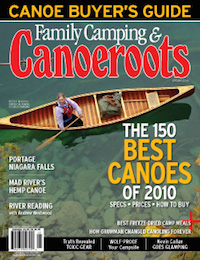Portage.
That’s what lakewater trippers do—we portage. From lake to lake, into remote wilderness, we heft mounds of stuff, all intricately organized into wannigans, canvas packs and polyethylene barrels. Yokes dig into our tired muscles as 60-pound canoes balance precariously on our shoulders. We are like oxen plowing the last furrow of the day, ready to unburden our load.
Many sport enthusiasts willingly subject themselves to torturous masochistic prac- tices—boxers accept head punches, cyclists wear tight spandex and canoeists…well, we portage.
It’s no wonder the word portage is often synonymous with gruelling pain and agony. As renowned canoeist Bill Mason once reminded us, “…portaging is like hitting your- self on the head with a hammer: it feels so good when you stop.”
So, when it came to planning a 200-day ca- noeing expedition, my husband and I found a way to paddle days on end, enjoying wide-open views, endless scenery, crystal clear wa- ter and the full gamut of weather conditions with no portages. Well…except for one. I will get to that later.
If you are a serious lakewater tripper, you must travel some of the coastline of the five immense lakes that shape the heart of North America—the Great Lakes. Vast and diverse, they are the largest chain of freshwater lakes on the planet, holding 20 per cent of the world’s freshwater.
Over the last three summers, we paddled this ancient waterway, travelling the entire 4,000-kilometre coastline of the Canadian Great Lakes from the Pigeon River, west of Thunder Bay, to Kingston on Lake Ontario, where the Great Lakes flow out the St. Lawrence River.
Along the way, we paddled the shores of Lake Superior, Lake Huron, Lake St. Clair, Lake Erie and Lake Ontario.
Each lake lives up to its great reputation. Lake Superior is the deepest, its greatest depth at 406 metres. Lake Huron is home to Manitoulin, the largest freshwater island in the world. Lake Erie boasts endless sand beaches around Long Point, Rondeau and Point Pelee and supports the richest aquatic life of all the lakes, a total of 46 million fish. And Lake Ontario offers its own challenges when your route takes you right through the busy city waterway of Toronto harbour. Oh, and there is only one portage. It happens to be 25 kilometres long, around a pretty major waterfall—Niagara.
THE COUNTDOWN TO P-DAY
After two blissfully portage-free summers, preparations for our third summer had begun and we were inadequately prepared for the 25-kilometre hike ahead. The longest portage in our combined portfolios was a mere three kilometres, but we felt confident in the helping hands of friends and family eager to lend their support in what was soon coined, P-Day.
As P-Day drew closer, however, our helpers dropped faster than the 100,000 cubic feet of water that flows over Niagara’s brink every second. We heard the full range of excuses, from dentist appointments to busy work schedules. Instead of a brigade, we were reduced to three helpful saints, who made the one-day carry possible. Portage technology had also advanced since the fur trade and we were well equipped with a modern canoe trolley that proved invaluable. Some call it cheating, but after a few kilometres, I call it smart. I’ll bet not one voyageur would rather carry a barrel of whiskey than roll it.
The Niagara Falls Review, the oldest newspaper in Ontario, reported that no one had portaged the route in recent history. It’s estimated that the last portage taken was over a hundred years ago. The ancient trail, however, is still intact—now paved and suitably bearing the name Portage Road.
As we approached the brink of Niagara Falls on foot, with our canoe in tow, citizens and vacationers sent worried glances in our direction. It was understandable considering that, in their lifetimes, more people have paddled over the falls than portaged around them. Within minutes a police cruiser pulled up and out stepped two straight-faced uniforms.
“I hope there’s no law against portaging, officer,” my husband said with a smirk. After telling our story, the police were delighted to help us out, making routine visits throughout the day. “I’m happy we weren’t the first portagers to be arrested,” I said as they sped away to another call.
The busloads of tourists filling the sidewalks proved no more difficult to navigate than overgrown balsam on a seldom-used trail. The crowds also made for an interesting portage, as we were an attraction ourselves, posing next to our canoe for hundreds of snapshots.
Stops at places like the Hershey’s Chocolate Factory and Candy Planet fuelled the journey. The 25 kilometres rolled on and by the end of the day we rested and dined lavishly at Peller Estates Winery. With a fine glass of private reserve, barrel-aged golden Chardonnay, we toasted our fun-filled day, a bit sad that it was all over. Because as Bill Mason also wrote, “It’s the portage that makes travelling by canoe unique.”
Stephanie Park is the new editor of Canoeroots magazine and has rekindled her love of portaging.



